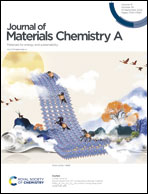Taming polysulfides in sulfur-based batteries via electrolyte-soluble thiomolybdate additives†
Abstract
The promise of secondary sulfur-based batteries as a sustainable and low-cost alternative to electrochemical energy storage has been long held back by the polysulfide shuttle problem. Herein, we demonstrate the utilization of electrolyte-soluble additives based on (oxo)thiomolybdate as a tool to mitigate the effect of the polysulfide shuttle in secondary sulfur-based batteries. Through a variety of techniques, it is shown that the Mo-containing anionic additives undergo spontaneous nucleophilic reactions with the highly soluble, long-chain polysulfides via a neutral S-atom transfer process, yielding higher S/Mo ratio complexes along with short-chain polysulfides. More importantly, it is shown how the O/S atomic substitution on the molybdenum center can induce enzymatic-level enhancement in the above reaction rate by lowering the homolytic S–S bond cleavage energy. Lastly, through anode-level inspections, it was realized that the dendritic electroplating of Li was suppressed considerably in the system with oxo/thiomolybdate, thereby reducing the cell impedance and overpotential, leading to significantly improved cycle-life. The positive influence of the increased polysulfide uptake reaction kinetics is evidenced by stable cycle-life and a low capacity-fade rate of 0.1% per cycle in Li–S cells with a high sulfur loading and lean electrolyte compositions.



 Please wait while we load your content...
Please wait while we load your content...